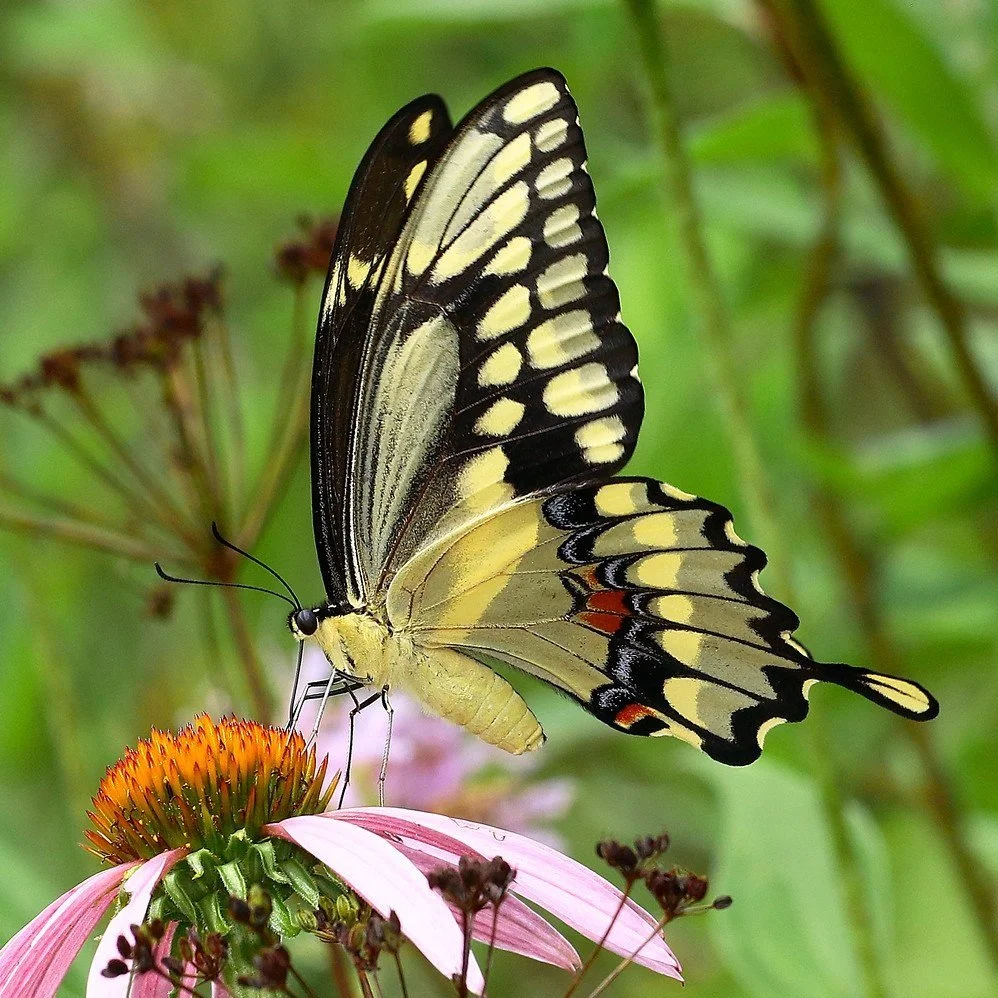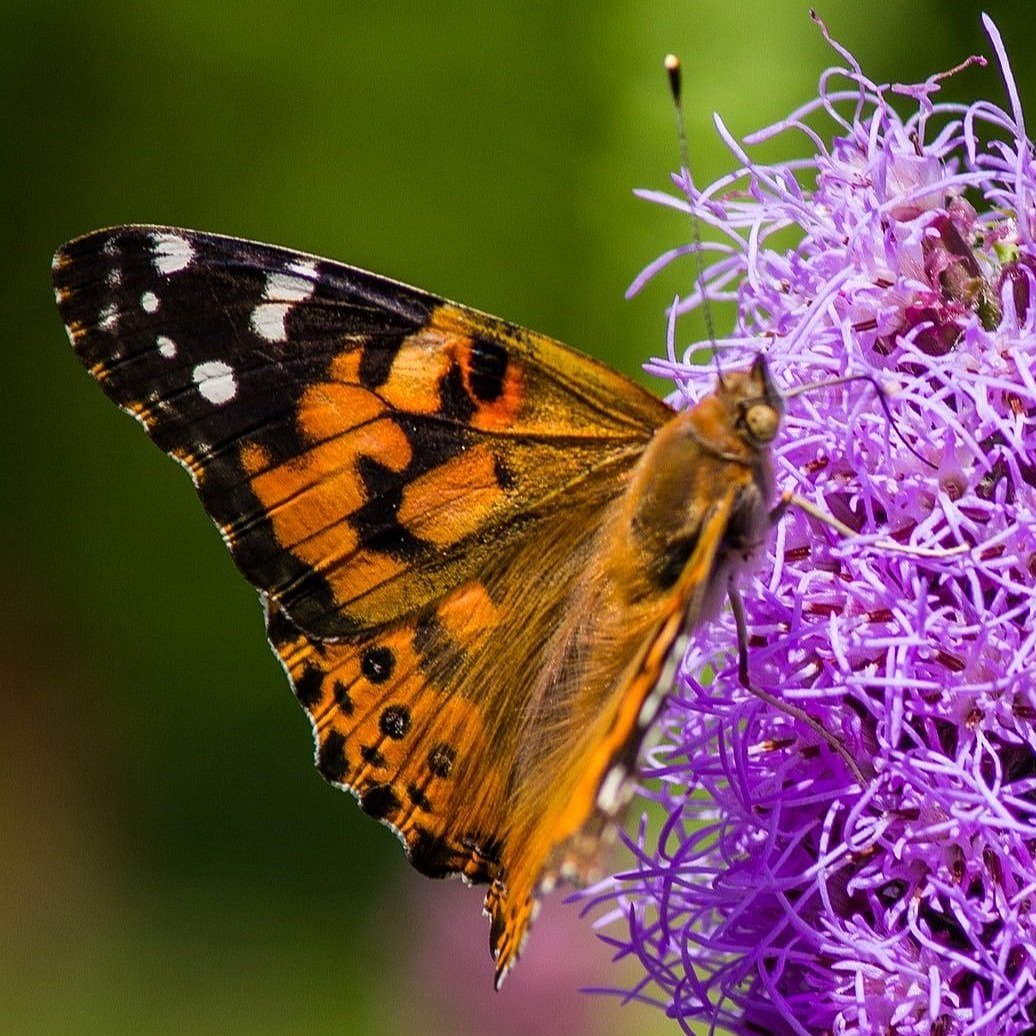
Common Kansas Butterflies
Over 190 different species have been documented within Kansas, but we’ll stick to the most common ones.
Detailed species profiles coming soon.

Monarch
Tiger Swallowtail

Black Swallowtail

Giant Swallowtail

Painted Lady

Red Admiral

American Lady

Gulf Fritillary

Viceroy

Buckeye

Variegated Fritillary

Question mark

Hackberry Emperor

American Snout

Cabbage White

Silver-Spotted Skipper

Gorgone Checkerspot

Bordered Patch

Clouded Sulphur

Firey Skipper
Full List of KS Documented Species
The following uses information sourced from The Great Plains Nature Center’s “Checklist of Kansas Butterflies” and the Butterflies and the Moths of North America’s online database.
Species recorded in Kansas whose normal range is in an adjoining state are indicated as strays.
BRUSH-FOOTS
(Nymphalidae)
Libytheinae (Snouts)
American Snout - All
Danainae (Milkweed Butterflies)
Monarchs - All
Queens - Stray S 1/2
Eratics - Extremely rare, but documented
Tiger Mimic-Queen {normally South}
Satyrinae (Satyrs & Wood-Nymphs)
Northern Pearly Eye – Stray E 1/4
Gemmed Satyr – Stray SE 1/8
Little Wood Satyr – E 2/3
Red Satyr – Stray SW
Common Wood Nymph - All
Eratics - Extremely rare, but documented
Creole Pearly Eye {normally SE}
Eyed Brown {normally N}
Carolina Satyr {normally SE}
Heliconiinae (Longwings)
Gulf Fritillary - Stray S
Eratics - Extremely rare, but documented
Julia {from the South}
Zebra Longwing {normally S}
Isabella’s Heliconian {normally S}
Banded Orange Heliconian {normally S}
Limenitidinae (Admirals & Relatives)
Red-spotted Purple - E 1/2
Viceroy - All
California Sister – Stray SW
Eratics - Extremely rare, but documented
Weidemeyer’s Admiral {normally W}
Many-banded Daggerwing {normally S}
Ruddy Daggerwing {normally SW}
Apaturinae (Emperors)
Hackberry Emperor - All
Tawny Emperor – E 2/3
Nymphalinae (True Brushfoots)
Variegated Fritillary - All
Great Spangled Fritillary – NE 2/3
Aphrodite Fritillary – Stray N
Regal Fritillary – All, Stray W 1/2
Edwards’ Fritillary – Stray W
Fulvia Checkerspot – W 1/2
Bordered Patch – SW 1/4
Gorgone Checkerspot - All
Silvery Checkerspot – E 1/2
Graphic Crescent – Stray S
Phaon Crescent – SE
1/2 Pearl Crescent - All
Painted Crescent – W 1/4
Baltimore Checkerspot – Stray E
Question Mark - All
Eastern Comma – NE 1/2
Hoary Comma – Stray W
Gray Comma – E 1/4
Mourning Cloak - All
American Lady - All
Painted Lady - All
West Coast Lady – Stray W
Red Admiral - All
Common Buckeye - All
Eratics - Extremely rare, but documented
Texan Crescent {normally S}
Field Crescent {normally W}
Dotted Checkerspot {normally W}
Milbert’s Tortoiseshell {normally W}
White Peacock {normally S}
Malachite {normally S}
Biblidinae (Tropical Brushfoots)
Eratics - Extremely rare, but documented
Florida Purplewing {normally S}
Common Mestra {normally S}
Charaxinae (Leafwings)
Goatweed Leafwing - All
Eratics - Extremely rare, but documented
Tropical Leafwing {normally S}
SWALLOWTAILS
(Papilionidae)
Eastern Black Swallowtail - All
Eastern Tiger Swallowtail - E 2/3
Giant Swallowtail - E 1/2
Pipevine Swallowtail - All but NW 1/8
Spicebush Swallowtail - Eastern 1/4
Zebra Swallowtail - SE 1/4
Anise Swallowtail - Stray W
Eratics - Extremely rare, but documented
Baird’s Old World Swallowtail {normally NW}
*Thoas Swallowtail {normally S}
*Ornythion Swallowtail {normally S}
*Two-tailed Swallowtail – Stray W
*Ruby-spotted Swallowtail {normally S}
WHITES, SULPHURS, AND ORANGE-TIPS
(Pieridae)
Checkered White - All
Cabbage White - All
Olympia Marble - All
Falcate Orangetip – SE 1/4
Clouded Sulphur – All
Orange Sulphur - All
Southern Dogface - All
Cloudless Sulphur - All
Mexican Yellow – All but NE 1/8
Little Yellow – E 2/3
Sleepy Orange – All but NW 1/8
Dainty Sulphur - All
Erratics - Extremely rare, but documented
Florida White {normally S}
Western White {normally W}
Great Southern White {normally S}
Giant White {normally S}
White Angled-Sulphur {normally SW}
Orange-barred Sulphur {normally S}
Apricot Sulphur {normally S}
Large Orange Sulphur {normally S}
Statira Sulphur {normally S}
Lyside Sulphur {normally S}
Tailed Orange {normally S}
Mimosa Yellow {normally S}
GOSSAMER-WINGS
(Lycaenidae)
Harvester – E 1/4
American Copper – Stray E
Gray Copper -All
Bronze Copper - All
Purplish Copper – Stray NW
Great Purple Hairstreak – Stray S
Soapberry Hairstreak- SC 1/4
Coral Hairstreak – All but W 1/4
Acadian Hairstreak – Stray N
Edwards’ Hairstreak – Stray E
Banded Hairstreak – E 2/3
Hickory Hairstreak – Stray E
Striped Hairstreak – NE 1/8
Southern Hairstreak - SE 1/4
Henry’s Elfin – E 1/3
'Olive' Juniper Hairstreak – E 2/3
White M Hairstreak – Stray E
Gray Hairstreak - All
Red-banded Hairstreak – Stray SE
Western Pygmy-Blue – SW 1/4
Marine Blue – All but NE 1/8
Reakirt’s Blue - All
Eastern Tailed-Blue - All
Spring Azure – All
Summer Azure - All
Silvery Blue {W}
Melissa Blue – W 1/2
Lupine Blue – W 1/2
Eratics - Extremely rare, but documented
Dusky-blue Groundstreak {normally S}
Gray Ministreak {normally S}
Cassius Blue {normally S}
Ceraunus Blue {normally S}
SKIPPERS
(Hesperiidae)
Sleepy Duskywing – Stray E
Juvenal’s Duskywing - E 1/4
Horace’s Duskywing – E 1/2
Mottled Duskywing – Stray E
Funeral Duskywing – All
Wild Indigo Duskywing – E 1/2
Common Checkered-Skipper - All
Common Sootywing – All
Swarthy Skipper – Stray SE
Least Skipper – All
Orange Skipperling - W 1/4
Fiery Skipper – All
Uncas Skipper – W 1/3
Ottoe Skipper – All
Leonard’s Skipper – NW 1/4
Pahaska Skipper – Stray W
Cobweb Skipper – Stray SE
Green Skipper – W 1/3
Dotted Skipper – Stray SC
Rhesus Skipper – Stray W
Peck’s Skipper – NE 1/4
Tawny-edged Skipper – E 1/2
Crossline Skipper – E 1/2
Southern Broken-dash – Stray SE
Northern Broken-dash – Stray E
Little Glassywing – Stray NE
Sachem - All
Arogos Skipper – All but SW 1/4
Delaware Skipper – All
Byssus Skipper – SE 1/4
Hobomok Skipper – E 1/2
Zabulon Skipper – E 1/2
Dion Skipper – Stray SE
Two-Spotted Skipper – Stray N
Dun Skipper – All
Dusted Skipper - All
Bronze Roadside-Skipper – Stray SW
Linda’s Roadside-Skipper - Stray SE
Oslar’s Roadside-Skipper – W 1/4
Nysa Roadside-Skipper- E 2/3
Common Roadside-Skipper – All
Bell’s Roadside-Skipper – SE 1/4
Eufala Skipper – All
Yucca Giant-Skipper – W 1/2
Strecker’s Giant-Skipper – SW & NW
Erratics - Extremely rare, but documented
Hermit Skipper {normally S}
White-patched Skipper {normally S}
Columbine Duskywing {normally NE}
Afranius Duskywing {normally W}
Persius Duskywing {normally W}
Mexican Sootywing {normally SW}
Russet Skipperling {normally W}
Clouded Skipper {normally SE}
Dotted Roadside-Skipper {normally SW}
Brazilian Skipper {normally S}
Schwilling, Marvin, and Charles Ely. “April 1991 by Marvin Schwilling and Charles Ely.” Edited by Jim Mason, Great Plains Nature Center, Kansas School Naturalist, Apr. 1991, https://gpnc.org/wp-content/uploads/sites/32/2017/11/CheckKsBflies.pdf.
“Family Nymphalidae (Brush-Footed Butterflies).” Family Nymphalidae (Brush-Footed Butterflies) | Butterflies and Moths of North America, https://www.butterfliesandmoths.org/taxonomy/Nymphalidae.

